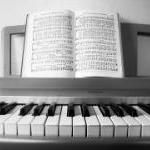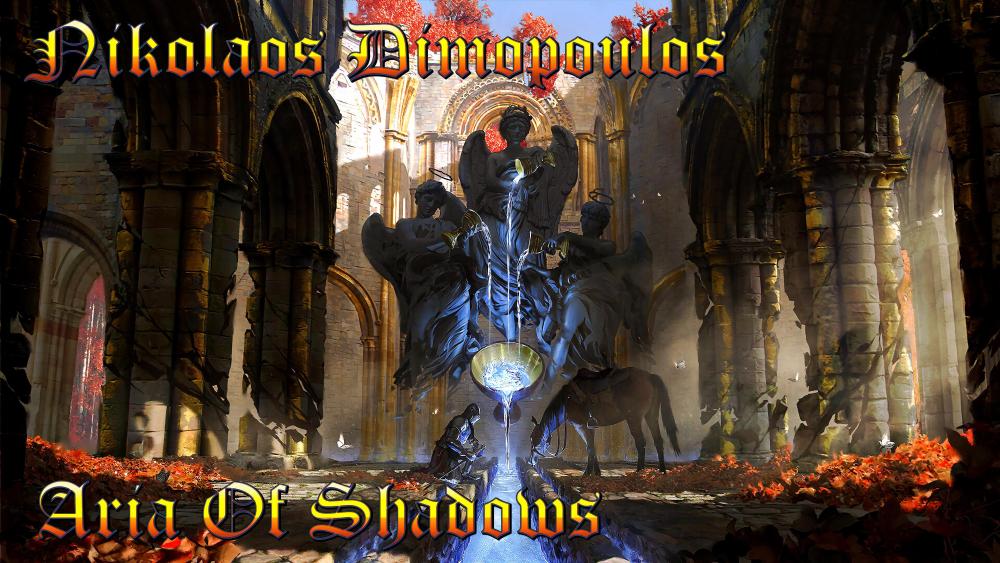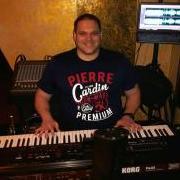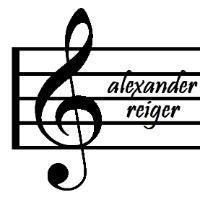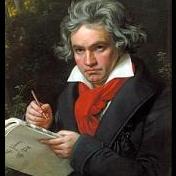Search the Community
Showing results for tags 'strings'.
-
Hello everyone, I'm back, at least for the moment. I wanted to share one of my in-progress arranging projects and humbly ask for your criticism. I decided to write a string quartet version of a Caroline Polachek song I love (linked at the bottom.) A PDF, Finale file, and audio file are linked below: https://www.dropbox.com/scl/fo/ljosc9l0xfy0k6fc6r69d/h?rlkey=aml3pst90rdspugzuyiyjllb2&dl=0 If you use Finale, please open the Finale file. (You should have no issue if you hit download after the "Can't load this file type" prompt.) In my mp3 the violin 1 part is absent; I'm not sure why. This is apparently a glitch with the software. My apologies! I am working on transferring the audio to my DAW, but until then, I hope this audio is still helpful in some way to those who don't have Finale. Backstory and questions In my notation and score prep class at music school, we were given an extra credit challenge to post a composition or arrangement online and make it buyable over the next month -- I am aiming for mid-April 2024. At the moment I'm thinking I will sell my score on ArrangeMe. https://www.arrangeme.com/ My works mostly fall under the classical umbrella, but during my past year at college and especially in this current class I've notated very short excerpts and arrangements of pop and rock songs. This "Butterfly Net" arrangement is more extensive, though, and I'm having some doubts about it in terms of texture, rhythm, and narrative pace. I really want to do this beautiful song at least some justice and I would greatly appreciate your advice. (My class focuses on notation itself and not at all on composition, but I would like whatever I publish online to be compositionally solid.) I know that arrangements fall on a scale of very faithful to more transformative. For example, Josh Cohen's piano arrangement of "Paranoid Android" by Radiohead is closer to the latter, because Cohen created a spacious intro with a completely different mood than the original, and he extends and reworks later sections within the song. I would like to be faithful to Polachek's formal structure and honor her precise harmonies and melodic lines (I simplified some rhythms) -- because I don't have much time. A string quartet obviously has many limits and I have some specific questions: - I have the pizz. cello emulate the guitar in the beginning, and in the chorus the viola plays pizz. to add rhythmic interest where the percussion was. Is this effective, or distracting? - Am I changing textures too quickly throughout the piece so far? I would like to slowly build the energy and drama. - In bar 19 I considered having the viola continue playing a rhythmic part, but I recognize that it's basic practice not to have all four instruments playing together for the entire piece. Without the viola, bar 19 onwards sounds silly and anemic to me. How could I add some lushness that the original has without exhausting my ensemble? Thank you so much for reading and for listening! Please hear the original "Butterfly Net" below, and an audio file of my arrangement:
- 9 replies
-
- string quartet
- arranging
-
(and 2 more)
Tagged with:
-
I wrote an arrangement of "The First Noel" for a string quartet I started working on this piece thinking very SATB, very chordal - but as I worked on it, I tried to think of the harmonies in terms of "lines" instead of just chords and I played around with the ranges of the strings. - I am not the best at writing viola parts, so there are some missing sections - if you have any ideas for harmonies let me know - I have looked at the score too long to notice any part-writing errors, so if you spot any, please point them out - I plan to keep working on this, but I think this is a good length for the piece - not TOO long, but long enough for the music to move and expand
- 5 replies
-
- 1
-

-
- christmas
- work in progress
-
(and 3 more)
Tagged with:
-
Up until recently I was in the process of making music for a short film. The film was about a girl who gains "superpowers" from an old tree, and with these superpowers she's able to save her dying father and the forest. When i sent them my music they immediately said that they hade chose to pursue other options with the motivation being the music was too different from what they had in mind. I'd love to receive some basic feedback on this short piece. I'd like to know wether if it's straight scraggy or if it's alright, if there's something missing and what that could be. I'll be glad for any opinion on my work. I have some confidence in my ability to create music, but since I'm working by myself I never really have any idea what others think, so just a couple of words of opinion would make my day. Thanks 😊
- 3 replies
-
- percussion
- strings
- (and 4 more)
-
Nikolaos Dimopoulos - Aria Of Shadows Hi everyone! I am new here and I am very happy to join this forum! As a new member I'm hungry for honest feedback! So, this is one composition of mine with choirs, orchestra and a fast waltz finale! Good listening!
-
Hi! This is the second draft of a String Quartet I've written. This is just the first movement. I'd like to get some feedback! (For some reason the file name doesn't have the #) OH and the playback took it really slow, it's more towards the bar = 80 or 90 or so.String_Quartet_in_C_minor.pdf String_Quartet_in_C_minor.mp3 String_Quartet_in_F_Movement_II.mp3
-
Just yesterday I sat at the piano for hours trying to figure out a simple riff or a motive that feels unique/different. I finally decided on a basic G Major phrase that would repeat itself or "stand out" in my 15th Concerto classical composition. The finish is a little bit of a reach out however it seems to achieve solid closure and resolve the composition.
-
1. Playtime link This is the first movement of six for a string quartet. The entirety of the piece is based on the relationship of four siblings as they grow up, each instrument representing a sibling. The first movement is the birth of the two eldest, hence it being simply a duet. I would love feedback on it and how to make it better. Is it too short? Does it end too abruptly? Does it need more of a recurring theme or melody than it has?
- 1 reply
-
- classical
- string ensemble
-
(and 3 more)
Tagged with:
-
You may need to turn your speakers/headphones up, i've been having some problems bringing my mix level up. Let me know what you think.
- 8 replies
-
- 2
-

-
- piano
- orchestral
-
(and 3 more)
Tagged with:
-
Here's a song I wrote for an indie game project called Cursed Chasm. Client wanted me to start the music sound creepy, then develop into metal music, so I did in that way. Hope you enjoy.
- 1 reply
-
- game
- game music
- (and 4 more)
-
This piece Persia II is a "sequel" to my "Persia" from 2011. Some of you in this forum suggested I'd right a suite or something in that direction, so I decided to try it. I do not want feedback on my old piece (Persia) in the YouTube link. I'm only attaching it so you can listen and hear the connection between the two. - Does this sequel "Persia II" work as a part two? - Will it be playable at written tempo? I want it to be the same tempo as "Persia", so it will feel as a double time. - See what I did with Da Capo? 🙂 Could it work?
- 5 replies
-
- 2
-

-
- string ensemble
- polyphony
-
(and 2 more)
Tagged with:
-
2Violins.mp3
-
Hey!! I finished this piece with the intention of making 2 other movements to compliment it, but I run into a problem on what the other movements should sound like. I'm debating on if I should mimic the styles of Britten's "Simple Symphony op.4" or if I should follow the concept of Bartok's String Quartet no.4 Let me know what best suits this quirky piece, enjoy!!
- 1 reply
-
- strings
- chamber work
-
(and 2 more)
Tagged with:
-
2orch.mp3
-
This is my second attempt at a divertimento in the classical style. It's meant to be a light and enjoyable work for a small string ensemble (I tried to make it possible for either a quartet or a larger section). I'm primarily doing these divertimentos as exercises in improving my four-part writing. One of the unifying factors between the movements is a consistent emphasis on weak beats throughout the piece, although I may have gotten a bit carried away with this aspect. I also sneaked a few bVII chords in to a couple of the movements. Let me know what you think! Thanks for listening.
- 4 replies
-
- 1
-

-
- divertimento
- strings
-
(and 1 more)
Tagged with:
-
Overture for String Orchestra Official - Flow 2.mp3 Overture for String Orchestra Official - Flow 3.mp3 01 - Full score - Overture for String Orchestra (1).pdf This is a work-in-progress for my youth chamber orchestra that I started in March 2020, and I envision it being between six and eight minutes long. The file titled "Flow 2" is the beginning of the work, joyful and energetic, and the one titled "Flow 3" is a heartfelt violin solo meant to come near the end. I have also attached the score. I have become stuck with this Overture, and am unsure what to do after that brief recap of the beginning. How can I tie the violin solo into the rest of the piece? And how can I heighten the drama? Any feedback and advice would be appreciated. Thanks, MissCello
- 2 replies
-
- string orchestra
- strings
-
(and 1 more)
Tagged with:
-
A waltz I composed several years ago, which was originally a piano piece until I reworked it for string orchestra earlier this year. I'm trying to evoke a specific mood with this one – something beautiful but dangerous, elegant and alluring yet simultaneously threatening. As always, any feedback is welcome!
-
Hello Guys! I need help with this string quintet. I'm satisfied with the main theme at the beginning but I do not know how to continue the piece. As you can I see I have written two suggestions in the score, but I'm not really happy with any of them. The title is called "Child's play" because I was inspired by children playing in the schoolyard, and I want to keep the spirit for the song, that's why the sad part doesn't go well with the energy in the beginning. Oh, and I'm not sure what form to use, I was thinking "rondo". Thanks a lot for any help
-
Hi everyone! After 9 months, extensive editing and reworking, I have finally finished my full quartet! I tend to compose based on motifs and melodies, so I tend to reuse my motifs and musical ideas throughout the piece with the intention of a coherent flow throughout this quartet. The order is as follows: 1. Allegro Con Spirito in 12/8 time (7'45") Form: Conventional Sonata Form Introduction in D Major -> 1st Subject in D Minor -> 2nd Subject in A Minor -> Development and New Material in A Major -> Recapitulation of 1st Subject in D Minor -> Coda using fragments of 2nd Theme in D Minor The opening movement of the piece, the first movement sets the tone of the piece with its flowing nature, seamless transitions and exploration of its two subjects, with motifs used to keep its coherent flow. The piece starts off with a slow introduction further elaborated on in the 4th movement. I decided to use a early Romantic style of composition with 20th century elements. Dialogue was emphasised throughout the movement with a lot of imitation and antiphonal texture between instruments used throughout the piece. In addition, I explored the varying planes of tones throughout the piece, from choral-like segments to more polyphonic areas. Motifs used: 1-quaver-4-semiquaver rhythm, Melodic pizz. motif, offbeat quavers, Chromatism 2. Adagio Molto Rubato in 2/4 time (11'32") Form: Free Form The slow movement of the piece, the second movement sets out by exploring the contrasts between varying emotions and textures and the use of solo instruments in the scoring of a string quartet, where every instrument has their own cadenzas and solos dotted throughout. Each instrument was given its time to shine and play its own solos and melodies, with interspersing those moments with polyphonic instrumentation and texture typically associated with the quartet. Each main melodic phrase starts off with the fast lively piu mosso section before going into more sentimental, slower sections of the piece. The theme of the piece and main melodic material in the movement recurs periodically throughout the piece with variation and changes in instrumentation and tone colour. I also used a relatively contemporary technique where different parts of the melody and countermelody are played by different instruments in the same phrase. Motifs: Tremolo, Dotted-crotchet-2-semiquaver rhythm, Solo cadenzas and melodies, offbeat semiquavers 3. Scherzo, Molto Vivace in 3/4 and 4/4 time (4'59") Form: Rondo Form A Section in D Minor -> B Section in F Major/B-flat Minor -> A Section in D Minor, -> C Section in F Major -> Cello Cadenza in D Minor -> A' Section in D Minor -> Coda in D Minor The Scherzo of the quartet heavily makes use of quartets and further explores the fugue and unconventional choral-like textures for the quartet. With heavy use of the lively and catchy theme, interspersed with the chromatic fugal style of the other sections, it creates sharp contrast and variety in sound. I utilised very lyrical and easy to latch onto melodies to make this rondo much more memorable and enjoyable, with its fiery unison main theme and its fast liveliness especially accentuated by its running notes as countermelodies. Motifs used: Chromatism, quaver-2-semiquaver rhythm, ascending scales 4. Adagio - Allegro Con Fuoco in 4/4 time (8'07") Form: Rondo Form Introduction in F Major-> A Section in D Minor -> B Section in D Minor -> A Section in D Minor-> C Section in D Major -> D Section in A Minor -> Brief Recap to Introduction -> B Section in D Minor -> Combination of C and D Section in A Minor -> A Section in D Minor -> Coda in D Minor Th final movement of the quartet is very virtuosic and technically challenging with its fast running notes and sudden tempo changes, with the emphasis of unpredictability, rage and contrast as I was composing in mind of the COVID pandemic. The theme throughout remains constant to provide a sense of grounding in an otherwise chaotic and unpredictable piece, with the 3 other main melodic ideas varied through variations and instrumentations. It heavily uses cyclic form in its introduction and coda, bringing ideas from the first and third movement into the forays of the final movement. Motifs: Chromatism, Running Note Scales, Quaver-Crotchet-2-semiquaver rhythm, quaver pizz., melodic motif bridging sections, Arppegio running Notes I would greatly appreciate any feedback given towards the composition as it helps me improve my skill in composing. Feel free to leave suggestions in the comments. Thank you!
- 5 replies
-
- 1
-

-
- string quartet
- chamber
-
(and 1 more)
Tagged with:
-
Hi all, I already mentioned in this post I would share the score of my latest music track. I wrote it all first in StaffPad and then rebuild it again on my computer with my favourite libraries. Love to receive some feedback. I really tried to pay attention to harmony, counterpoint and using the right registers for the instruments. Download score: https://bit.ly/3ka0ZLu
-
This is a piece I started composing last night after listening to String Duo for Violin and Cello in D major by Haydn. I felt like composing a piece in B minor for some reason, don't know why, maybe because I haven't really used B minor all that much in 3 years of composing. But as I started listening to it, it sounded more to me like a slow second movement than an isolated work. But what piece would have a slow movement in a minor key outside of the exceptions like Moonlight Sonata where the slow movement is the first movement and suites where the key relations aren't necessarily close? What I'm composing seems to be more like the slow movement of a sonata than a suite. I mean for one thing, piano sonata slow movements do tend to have this 2 melodies thing(bass clef melody as well as treble clef melody) that is certainly in my piece. And from all my experience listening to both solo and duet sonatas, not once have I heard a minor key second movement, although such a sonata probably exists. Anyway, what do you think of it so far? Starting at measure 12, I have a cello solo, as you can probably tell by me going into tenor clef for more than just a few bars and how high up in tenor clef it gets. I don't think the violin will just wait until the solo is finished, but I do want to give at least 1 measure to just the cello before I bring the violin back in in its low register and in more of the melodic bass role the cello had before the solo. I might change the "in B minor" part of the title if I do decide to go full on sonata with this piece. I might even change "String Duo" to "Duo Sonata for Violin and Cello" if I do that.
-
I wanted to put a sound to my dreams and I feel this piece best suits it!! Leave a comment and enjoy!! Sheet Music: https://flat.io/score/5ed7175b0e11096fbd93d018-lucid-dreams
-
As a religious person myself, I encountered different spiritual warfare everyday and one day I tried to create the warfare with music. I ended up writing a string orchestra piece with some interesting harmonies and repetitive melodic shape. I think I'm starting to discover my kind of harmony which is great, hope you all enjoy this 🙂
- 3 replies
-
- 1
-

-
- orchestra
- stringorchestra
-
(and 1 more)
Tagged with:
-
Hi everyone! This is the 3rd movement of my string quartet! In contrast to the meandering 2nd movement which does not have any structure, this movement is mostly following the Rondo form, and I used motifs extensively throughout the piece. This was also the first time where I tried using parallel motion for the theme and climax of the movement to contrast the episodes which are more polyphonic and uses more call-and-response. I also included a quasi cadenza for the cello before the reprisal back to the opening of the piece, with a fiery cadenza to end the piece! Let me know what you guys think and feel free to feedback in the comments! Thank you for taking the time to listen!
-
This post will be my opinions and takes on the string quartet, that will apply to all genres of the string quartet. For anyone who is interested in writing string quartets, I shall try to give my best unorthodox pointers and tips on how to make a string quartet better, and utilise each instrument to the best of its ability. Personally, I am an amateur string player since young who has both avidly listened to and played numerous string quartets and I tend to take inspiration from the quartets that I listen to while composing my own quartets. Now, let me discuss some of the pointers: 1. Make as much contrast as possible. Be it a major key, minor key, loud, soft, monophony or polyphony, I believe that contrast is the single most important essence to a good quartet. A good quartet needs a lot of contrast, to keep the quartet interesting to the ear and creates variety in sound. No one instrument should overpower the others in the melody and relegate the other instruments to a form of accompaniment for the entire piece. Playing some of the accompaniment parts personally before, it can be rather dull for them and it creates a dull effect where there's not much dialogue or antiphony between the instruments. One often overlooked way to create contrast is through the texture of the quartet. However, I disagree with the notion that counterpoint should be used at all times and to avoid parallel motion or chorale-like melodies at all costs. While counterpoint is very good at creating unique quartets and is key to a good quartet, when used correctly, parallel motion or monophonic themes across all instruments can elevate a quartet to another level (especially in a climax of a piece). It should be used sporadically at key moments during a piece, to highlight a certain motif or theme, or contrast an otherwise fully polyphonic section, one example of this brilliantly done is the opening of Beethoven's Grosse Fugue. There are many ways to create contrast, and after studying many quartets I realised that every composer has a unique way of creating that sense of contrast in their pieces. It's important to find one's preferred method to develop contrasts in their quartet. 2. Make more use of multiple stops. Double stops is a great way to add challenge and a unique texture to a quartet. However, it may be daunting for composers who have never dealt with strings. For this, I would advise that (90%) double stops with intervals 8ve or less in a chord are playable (the occasional 10th is possible but not for prolonged periods), and for triple/quadruple stops, try to stick to 5th or 6th intervals between individual notes to be safe. The exception to these rules is always the open string. As string players do not need to place their left hand fingers down when playing open strings, any interval that can use the open strings tend to be much easier for a string player to manage and allows for greater intervals between notes. 3. (Good) transitioning is much harder than meets the eye. For myself, I started composing more than a year ago. Still, even with my prior experience with string instruments and repertoire, it took me >20 tries across 7-8 different pieces to get transitions to a decent state. (I was working on string orchestra pieces back then, similar to the quartet) Even now, I wouldn't call myself a good composer in transitions and I still frequently struggle with transitions. The main difficulty of transitioning especially in a string quartet is not so much like orchestral or solo pieces, where you can find a pivot chord and modulate quickly without a hitch. Rather, it is because of the string quartet's unique nature where frequent contrasts in the music are required and the counterpoint across different instruments that makes it hard. Trying to bridge a very loud, climatic section with a very soft, intimate section within the span of a few bars is very daunting in string quartet writing. If anyone is interested, I can make an entirely separate post just on transitioning and some methods I have picked up through prior work on string writing. 4. Don't be afraid to cross registers. Some composers who are new to quartet writing often view the string quartet as SATB writing for strings. While this has some merit, this is not entirely true. String quartet writing is very fluid in the fact that there are many styles. In romantic and 20th century string quartets, it is very common for the registers of different instruments to continuously cross over one another to create variety and effect. Any instrument, even the cello at times, can take the highest register out of the 4 instruments at any given point of a quartet. (This is why many quartets let the cello play up to even D7 or two octaves above middle C frequently!) Don't hesitate to try crossing the registers of the different instruments over, and a good place to start would be with the viola and cello alternating registers. 5. Practice makes perfect. This is especially apparent for string quartet. No matter how much analysis of famous quartets, the best way to compose a good quartet is through prior practice. It took me many tries to at least reach a decent level in string writing. Try practicing across a wide range of styles and genres of the string quartet 6. Lastly, string quartet is not a dead medium. This was actually a view held by many late Romantic/Impressionistic composers, who felt that String Quartet was a dead medium where not much new styles or forms can be pioneered and all possible iterations and styles have been exhausted. This is why many of such composers (Debussy or Ravel) composed only one quartet. However, this was clearly proven otherwise when 20th century composers turned the medium on its head and pioneered an entirely new way to compose the string quartet. Some composers now have the same view as the Late Romantic composers. However, string quartet is one of the most flexible and versatile mediums of classical music to date. It differs so greatly, from the classical quartets of Mozart and Haydn, to the Romantic Quartets of Mendelssohn and Dvorak, to the 20th Century Quartets of Shostakovich and Gliere. There is still so much more to discover for the string quartet and there are many examples where one-of-a-kind quartets have been produced. Let me just name an example: Grieg's String Quartet No. 1 in G Minor was very eye-opening for me. It is a very unique string quartet that focuses on the resonance of the open strings of string instruments and the virtuosity of its players. It is very intricate and heavily utilises double stops throughout its piece, to the point where even the original publisher rejected it for having too many double stops. However, it was indeed playable and it gave rise to a new form of string quartet, with its lyrical, fast-moving melodies and its sonorous sound, yet filled many sharp contrasts. I would suggest to anyone who is bored of string quartets to listen to this, and possibly gain inspiration. Such a unique thinking of the quartet has not been thoroughly explored yet and I urge others to explore the resonance of open strings in string quartet as sort of a challenge to anyone composing future string quartets haha this is the link to the quartet: This post will be my opinions and takes on the string quartet, that will apply to all genres of the string quartet. For anyone who is interested in writing string quartets, I shall try to give my best unorthodox pointers and tips on how to make a string quartet better, and utilise each instrument to the best of its ability. Personally, I am an amateur string player since young who has both avidly listened to and played numerous string quartets and I tend to take inspiration from the quartets that I listen to while composing my own quartets. Now, let me discuss some of the pointers: 1. Make as much contrast as possible. Be it a major key, minor key, loud, soft, monophony or polyphony, I believe that contrast is the single most important essence to a good quartet. A good quartet needs a lot of contrast, to keep the quartet interesting to the ear and creates variety in sound. No one instrument should overpower the others in the melody and relegate the other instruments to a form of accompaniment for the entire piece. Playing some of the accompaniment parts personally before, it can be rather dull for them and it creates a dull effect where there's not much dialogue or antiphony between the instruments. One often overlooked way to create contrast is through the texture of the quartet. However, I disagree with the notion that counterpoint should be used at all times and to avoid parallel motion or chorale-like melodies at all costs. While counterpoint is very good at creating unique quartets and is key to a good quartet, when used correctly, parallel motion or monophonic themes across all instruments can elevate a quartet to another level (especially in a climax of a piece). It should be used sporadically at key moments during a piece, to highlight a certain motif or theme, or contrast an otherwise fully polyphonic section, one example of this brilliantly done is the opening of Beethoven's Grosse Fugue. There are many ways to create contrast, and after studying many quartets I realised that every composer has a unique way of creating that sense of contrast in their pieces. It's important to find one's preferred method to develop contrasts in their quartet. 2. Make more use of multiple stops. Double stops is a great way to add challenge and a unique texture to a quartet. However, it may be daunting for composers who have never dealt with strings. For this, I would advise that (90%) double stops with intervals 8ve or less in a chord are playable (the occasional 10th is possible but not for prolonged periods), and for triple/quadruple stops, try to stick to 5th or 6th intervals between individual notes to be safe. The exception to these rules is always the open string. As string players do not need to place their left hand fingers down when playing open strings, any interval that can use the open strings tend to be much easier for a string player to manage and allows for greater intervals between notes. 3. (Good) transitioning is much harder than meets the eye. For myself, I started composing more than a year ago. Still, even with my prior experience with string instruments and repertoire, it took me >20 tries across 7-8 different pieces to get transitions to a decent state. (I was working on string orchestra pieces back then, similar to the quartet) Even now, I wouldn't call myself a good composer in transitions and I still frequently struggle with transitions. The main difficulty of transitioning especially in a string quartet is not so much like orchestral or solo pieces, where you can find a pivot chord and modulate quickly without a hitch. Rather, it is because of the string quartet's unique nature where frequent contrasts in the music are required and the counterpoint across different instruments that makes it hard. Trying to bridge a very loud, climatic section with a very soft, intimate section within the span of a few bars is very daunting in string quartet writing. If anyone is interested, I can make an entirely separate post just on transitioning and some methods I have picked up through prior work on string writing. 4. Don't be afraid to cross registers. Some composers who are new to quartet writing often view the string quartet as SATB writing for strings. While this has some merit, this is not entirely true. String quartet writing is very fluid in the fact that there are many styles. In romantic and 20th century string quartets, it is very common for the registers of different instruments to continuously cross over one another to create variety and effect. Any instrument, even the cello at times, can take the highest register out of the 4 instruments at any given point of a quartet. (This is why many quartets let the cello play up to even D7 or two octaves above middle C frequently!) Don't hesitate to try crossing the registers of the different instruments over, and a good place to start would be with the viola and cello alternating registers. 5. Practice makes perfect. This is especially apparent for string quartet. No matter how much analysis of famous quartets, the best way to compose a good quartet is through prior practice. It took me many tries to at least reach a decent level in string writing. Try practicing across a wide range of styles and genres of the string quartet 6. Lastly, string quartet is not a dead medium. This was actually a view held by many late Romantic/Impressionistic composers, who felt that String Quartet was a dead medium where not much new styles or forms can be pioneered and all possible iterations and styles have been exhausted. This is why many of such composers (Debussy or Ravel) composed only one quartet. However, this was clearly proven otherwise when 20th century composers turned the medium on its head and pioneered an entirely new way to compose the string quartet. Some composers now have the same view as the Late Romantic composers. However, string quartet is one of the most flexible and versatile mediums of classical music to date. It differs so greatly, from the classical quartets of Mozart and Haydn, to the Romantic Quartets of Mendelssohn and Dvorak, to the 20th Century Quartets of Shostakovich and Gliere. There is still so much more to discover for the string quartet and there are many examples where one-of-a-kind quartets have been produced. Let me just name an example: Grieg's String Quartet No. 1 in G Minor was very eye-opening for me. It is a very unique string quartet that focuses on the resonance of the open strings of string instruments and the virtuosity of its players. It is very intricate and heavily utilises double stops throughout its piece, to the point where even the original publisher rejected it for having too many double stops. However, it was indeed playable and it gave rise to a new form of string quartet, with its lyrical, fast-moving melodies and its sonorous sound, yet filled many sharp contrasts. I would suggest to anyone who is bored of string quartets to listen to this, and possibly gain inspiration. Such a unique thinking of the quartet has not been thoroughly explored yet and I urge others to explore the resonance of open strings in string quartet as sort of a challenge to anyone composing future string quartets haha (link to Grieg's string quartet: https://youtu.be/OM9hdCpdcqc ) That concludes my rather lengthy post on the string quartet, let me know if anyone wants me to delve into other parts of the string quartet. Happy composing! Edit: I should have posted this on another forum, I didn't realise this was for incomplete works and writers block, sorry



